Formica gerardi
| Formica gerardi | |
|---|---|

| |
| Scientific classification | |
| Kingdom: | Animalia |
| Phylum: | Arthropoda |
| Class: | Insecta |
| Order: | Hymenoptera |
| Family: | Formicidae |
| Subfamily: | Formicinae |
| Tribe: | Formicini |
| Genus: | Formica |
| Subgenus: | Serviformica |
| Species: | F. gerardi |
| Binomial name | |
| Formica gerardi Bondroit, 1917 | |
| Evolutionary Relationships | |||||||||||||||||||||||||||||||||||||||||||||
| |||||||||||||||||||||||||||||||||||||||||||||
| Based on Gomez, Lorite, P. et al. 2018. Note that this study was restricted to species near Formica gerardi. |
This ant has been associated with the butterflies Laeosopis roboris and Favonius quercus (Obregon et al. 2015).
Identification
Gómez et al. (2018) - The following combination of morphological characters has been used to isolate Formica gerardi from other close species (Formica lemani, Formica fusca, Formica decipiens and European Formica of the rufibarbis group). Ecological requirements and habitat types used by those species are also indicative – Formica gerardi is the most xerothermic species within European Formica– and are currently in use during field work.
- Colour light to dark brown, sometimes with reddish brown areas at the sides of pronotum and pro-mesonotum lateral juncture.
- Body surface appearing, at low magnification (<20X), as absolutely matte.
- Internal face of tibiae III with diluted pubescence. Pubescent setae could be described as flat, wide and very appressed over tibial surface. Instead, in Formica lemani, Formica fusca, Formica decipiens, and European Formica rufibarbis group, the internal face of tibia III pubescence density is much higher (see figure 2). Formica picea, strangely enough, approaches Formica gerardi condition in tibial pubescence density but has otherwise clear differences in surface shininess, pilosity and colouration.
- Pronotum and mesonotum with short erect setae
- Propodeum lower than in European Formica rufibarbis group species.
The long scapes and dull frontal triangle places it in the Serviformica subgenus, and its dull cuticle differentiates it from the rest of Iberian Serviformica queens in which scutellum is smooth and shining.
As in the worker and queen castes, the dull, mattete appearance differentiates the Formica gerardi male from all the other Serviformica males present in the Iberian Peninsula, which have shiny mesopleurae.
The species Iberoformica subrufa, the only member of its genus, is similar to this species and others in the Formica fusca group. See the identification section of Iberoformica for diagnostic characters that separate these taxa from one another.
Collingwood and Yarrow (1969) - This species is described by Bondroit (1917) as brown-black, very matt with short grey pubescence; anterior of head, sutures, antennae and legs lighter and with sparse hairs on head, gaster and pronotum. It is in effect like a dark Formica rufibarbis. The dorsal thoracic hairs in these examples are less concentrated on the pronotum than in F. rufibarbis, more scattered over the whole thorax, finer and fewer in number. The main structural difference between the two species is in the shape of the epinotum which is relatively lower and less massive in F. gerardi, having the ratio of length of dorsal surface to height as 8: 10 instead of about 7: 10.
Distribution
Latitudinal Distribution Pattern
Latitudinal Range: 43.445278° to 36.056389°.
| North Temperate |
North Subtropical |
Tropical | South Subtropical |
South Temperate |
- Source: AntMaps
Distribution based on Regional Taxon Lists
Palaearctic Region: Andorra, France (type locality), Gibraltar, Iberian Peninsula, Portugal, Spain.
Distribution based on AntMaps
Distribution based on AntWeb specimens
Check data from AntWeb
Countries Occupied
| Number of countries occupied by this species based on AntWiki Regional Taxon Lists. In general, fewer countries occupied indicates a narrower range, while more countries indicates a more widespread species. |

|
Estimated Abundance
| Relative abundance based on number of AntMaps records per species (this species within the purple bar). Fewer records (to the left) indicates a less abundant/encountered species while more records (to the right) indicates more abundant/encountered species. |

|
Biology
This species is a host for the ant Polyergus rufescens (a dulotic parasite) (Seifert, 2018; de la Mora et al., 2021).
Gómez et al. (2018) provided biological details about F. gerardi through a discussion of how this ant's biology could, in part, differentiate it from a similar species: Behavioral and ecological differences: Iberoformica subrufa and Formica gerardi share the fact of being thermophilic ants, living in the Mediterranean forests clearings. Although both species can share the same habitat occasionally, Iberoformica subrufa may be present in the same localities as other highly thermophilic species like Camponotus foreli or Cataglyphis velox, while Formica gerardi is more dependent on shaded areas. Being less thermophilic, Formica gerardi extends its distribution to the Northern Iberian meseta, where Iberoformica subrufa is present only in isolated areas, and the opposite in the South Iberian Peninsula, where Iberoformica subrufa is common and Formica gerardi needs forest-shaded areas to live. One main behavioral difference between both species is that Iberoformica subrufa has not known dulotic relation with Polyergus species, while various ants belonging in the fusca group are commonly enslaved by them. In its revision of the genus Polyergus, Trager writes about Polyergus rufescens: “I have series from the Pyrenees with Formica gerardi, where this is the most abundant potential host” (Trager, 2013: 511). One of us (F. García) has also found these two species in dulotic relation in Ayora (Valencia province, 39°06’59”N 1°12’37”W 850m , 18/02/2017), in a Pinus halepensis pinewood where Formica gerardi was one of the most frequent species. Iberoformica subrufa was also present and frequent but was never found in dulotic relation with Polyergus rufescens.
Castes
Worker
Images from AntWeb
   
| |
| Worker. Specimen code casent0280387. Photographer Shannon Hartman, uploaded by California Academy of Sciences. | Owned by PSWC, Philip S. Ward Collection. |
   
| |
| Syntype of Formica gerardi. Worker. Specimen code casent0912260. Photographer Will Ericson, uploaded by California Academy of Sciences. | Owned by NHMB, Basel, Switzerland. |
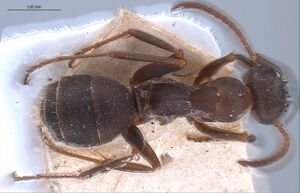 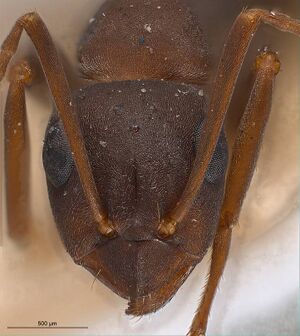   
| |
| Worker. Specimen code antweb1008399. Photographer Roland Schultz, uploaded by California Academy of Sciences. | Owned by IRSNB, Brussels, Belgium. |
Queen
Images from AntWeb
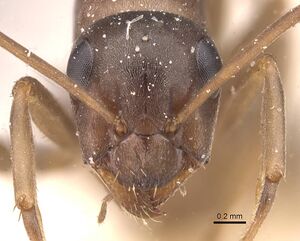 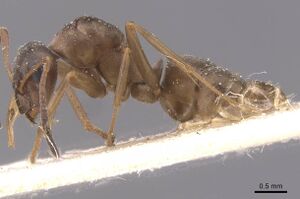 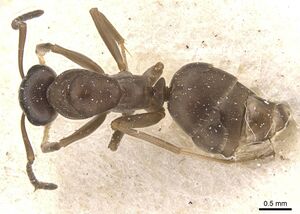 
| |
| Not part of a type series. Worker. Specimen code casent0912261. Photographer Will Ericson, uploaded by California Academy of Sciences. | Owned by NHMB, Basel, Switzerland. |
Nomenclature
The following information is derived from Barry Bolton's Online Catalogue of the Ants of the World.
- gerardi. Formica gerardi Bondroit, 1917b: 186 (w.) FRANCE.
- Lorite, Chica & Palomeque, 1998: 26 (k.).
- Combination in F. (Iberoformica): Czechowski, Radchenko, et al. 2012: 39.
- Combination in F. (Serviformica): Gomez, Lorite, et al. 2018: 464.
- As unavailable (infrasubspecific) name: Emery, 1925b: 247.
- Junior synonym of subrufa: Bernard, 1967: 301.
- Status as species: Bondroit, 1918: 53; Stärcke, 1926: 148 (in key); Schmitz, 1950: 14; Collingwood & Yarrow, 1969: 89; Collingwood, 1978: 94 (in key); Bolton, 1995b: 195; Casevitz-Weulersse & Galkowsky, 2009: 482; Borowiec, L. 2014: 75.
Unless otherwise noted the text for the remainder of this section is reported from the publication that includes the original description.
Description
Queen
Gómez et al. (2018) - HL=1.7 [1.36-1.91] , HW=1.71 [1.53-1.89] , SL=1.6 [1.3- 1.81] , EL=0.63 [0.55-0.74] , WL=3.13 [2.86-3.57] , PW=1.67 [1.3-1.9] , PLD=2.61 [2.33-2.97] , OI (EL/HW)=37 [33-48] , CI (HW/HL)=100 [95-112] , SI (SL/HW)=93 [84-100] , MI (PW/ HW)=98 [78-133] , MDI (PW/PLD)=64 [49-77] (n=9)
Head subquadrate, smaller basally. Mandibles striated, strong and with 6-7 acute teeth in the masticatory margin. Clypeus convex, with a medial carina. Frontal ridges short. Scapes long, surpassing the occipital border, funiculus with four first segments elongated, the remainder subquadrate. Pronotum dorsally visible and relatively low in lateral view in the smaller specimens. Scutum rounded in profile view, scutellum flat in profile view and subquadrate in dorsal view. Propodeum a straight line to the insertion with petiole. Scutoscutellum suture demarcated but not deep. Petiole squamiform, high, narrowly ovate in profile view. Subrectangular in frontal view, convex with a medial notch. Gaster as wide as mesosoma in dorsal view. Whole body covered with a short, whitish pubescence. Long, erect to semierect white setae present following the frontal ridges to occipital margin of the head (5 to 10), abundant on clypeus (10-15), numerous (>10) and sudecumbent on pronotal dorsum, semierect on dorsum of mesosoma (>20) and abdomen. Rest of the head, propodeum and petiole with appressed pubescence only. Body and head entirely shagreened and dull due to heavy sculpturation except frontal suture, central-anterior line of scutellum and two symmetrical lateral lines in its posterior half. Colour entirely dark brown to black, with the appendages lighter. A reddish band present in the borders of the pronotum and mesopleurae. Head below eyes and mandibles with a more or less developed reddish tinge.
Male
FGPCHL=1.30 [1.27-1.36] , HW=1.53 [1.48- 1.58] , SL=1.27 [1.23-1.33] , EL=0.73 [0.71-0.76] , WL=2.73 [1.18-3.28] , PW=1.92 [1.66-2.14] , PLD=2.70 [2.47-2.89] , OI (EL/HW)=47 [46-49] , CI (HW/HL)=117 [113-123] , SI (SL/HW)=83 [81-84] , MI (PW/HW)=146 [130-162] , MDI (PW/PLD)=71 [67-80] (n=5).
Head triangular, widest at apex, wider than long (CI~117), vertex convex, lateral a straight line; clypeus convex, medial carina weak but present; mandibles sublinear, slightly rugulose; apical tooth present, followed by a edentate border with 0-1 denticles; eyes large (OI~47); three conspicuous ocelli present and elevated over the rest of the head, the center one oriented forward, the other two laterally; frontal ridges absent, vestigial laterally with exposed antennal sockets. Scapes long (SI~83) surpassing the occipital border when laid back, the length between occipital border and apex clearly longer than distal to occipital border; funiculus filiform with all funicular segments longer than wide, similar in size. Mesosoma clearly wider than head (MI~146). Pronotum almost not visible in dorsal view, slightly depressed in the medial line. Scutum rounded, notauli absent, parapsidal lines clearly demarcated. Scutelllum rounded dorsally and laterally, elevated over the scutum. Posteropropodeum clearly longer than dorsopropodeum, rounded in lateral view. Petiole low; in profile view rounded, subovoid and almost symmetrical, with an acute apex; in frontal view trapezoidal, with straight dorsal line and vertical lateral sides connected by two 45 degree almost straight lines. Gaster long and cylindrical. Genitalia typical of genus Formica (Figures 4, 5). Sagitta with apex recurved and rounded, the border of its ventral half dentated. Digitus recurved. Dark brown to black, with legs and funiculus light brown to brown. Head surface mattete except for the frontal line from clypeus to central ocellus. Rest of body sculptured with the same pattern than worker, mattete (Figure 3). 1-2 pairs of semierect to erect setae on clypeus medially on clypeus, one on vertex and one setae more below each lateral ocelli. Mesosoma dorsally with scattered yellow, short semierect to erect setae, slightly longer than pubescence, absent on propodeum. Petiole with scattered erect short setae, as long as the pubescence. Whole body covered with yellowish, dense long pubescence, its length clearly longer than distance between pubescence lines, overlapping.
Karyotype
- See additional details at the Ant Chromosome Database.
 Explore: Show all Karyotype data or Search these data. See also a list of all data tables or learn how data is managed.
Explore: Show all Karyotype data or Search these data. See also a list of all data tables or learn how data is managed.
- n = 27 (Spain) (Lorite et al., 1998a; Lorite et al., 2002b).
References
- Bernadou, A., Fourcassié, V., Espadaler, X. 2013. A preliminary checklist of the ants (Hymenoptera, Formicidae) of Andorra. ZooKeys 277, 13–23 (doi:10.3897/zookeys.277.4684).
- Bernard, F. 1967a [1968]. Faune de l'Europe et du Bassin Méditerranéen. 3. Les fourmis (Hymenoptera Formicidae) d'Europe occidentale et septentrionale. Paris: Masson, 411 pp. (page 301, Provisional junior synonym of subrufa)
- Bondroit, J. 1917b. Diagnoses de trois nouveaux Formica d'Europe (Hym.). Bull. Soc. Entomol. Fr. 1917: 186-187. (page 186, worker described)
- Borowiec, L. 2014. Catalogue of ants of Europe, the Mediterranean Basin and adjacent regions (Hymenoptera: Formicidae). Genus (Wroclaw) 25(1-2): 1-340.
- Collingwood, C. A. 1978. A provisional list of Iberian Formicidae with a key to the worker caste (Hym. Aculeata). EOS. Rev. Esp. Entomol. 52: 65-95 (page 73, Revived status as species)
- Collingwood, C. A.; Yarrow, I. H. H. 1969. A survey of Iberian Formicidae (Hymenoptera). EOS. Rev. Esp. Entomol. 44: 53-101 (page 89, Revived status as species)
- Collingwood, C.A., Prince, A. 1998. A guide to ants of Continental Portugal (Hymenoptera: Formicidae). Boletim da Sociedade Portuguesa de Entomologia. Supl nº5, pp 49.
- de la Mora, A., Sankovitz, M., Purcell, J. 2020. Ants (Hymenoptera: Formicidae) as host and intruder: recent advances and future directions in the study of exploitative strategies. Myrmecological News 30: 53-71 (doi:10.25849/MYRMECOL.NEWS_030:053).
- Devenish, A.J.M., Newton, R.J., Bridle, J.R., Gomez, C., Midgley, J.J., Sumner, S. 2021. Contrasting responses of native ant communities to invasion by an ant invader, Linepithema humile. Biological Invasions 23, 2553–2571 (doi:10.1007/s10530-021-02522-7).
- Gomez, K., Lorite, P., Garcia, F., Tinaut, A., Espadaler, X., Palomeque, T., Sanllorente, O., Trager, J. 2018. Differentiating Iberoformica and Formica (Serviformica) with description of the sexual castes of Formica (Serviformica) gerardi Bondroit, 1917 stat. rev. Sociobiology 65: 463-470 (DOI 10.13102/sociobiology.v65i3.3315).
- Lorite, P., Chica, E. ; Palomeque, T. 1998. Numeros cromosómicos en los formícidos españoles. 1. Subfamilia Formicinae. Bol. R. Soc. Esp. Hist. Nat. Secc. Biol. 94: 23-31 (page 26, karyotype described)
- Obregon, R., M. R. Shaw, J. Fernandez-Haeger, and D. Jordano. 2015. Parasitoid and ant interactions of some Iberian butterflies (Insecta: Lepidoptera). Shilap-Revista De Lepidopterologia. 43:439-454.
References based on Global Ant Biodiversity Informatics
- Abril S., and C. Gomez. 2013. Rapid assessment of ant assemblages in public pine forests of the central Iberian Peninsula. Forest Ecology and Management 293: 7984.
- Acosta, F. J., M. D. Martínez Ibáñez, and M. A. Morales. "Contribución al conocimiento de la mirmecofauna del encinar peninsular. I." Boletín de la Asociación Española de Entomología 6 (2) (1983): 379-391.
- Aguirre Segura, A.. Los Aphidoidea de Almería (Insecta, Homoptera)., 1992.
- AntArea. Accessed on February 5th 2014 at http://antarea.fr/fourmi/
- Antarea (Personal Communication - Rumsais Blatrix- 27 April 2018)
- Antarea (at www.antarea.fr on June 11th 2017)
- Asociacion Iberica de Mirmecologia. 2011. List of species collected during the Taxomara Lisboa 2010. Iberomyrmex 3: 32-33.
- Asociacion Iberica de Mirmecologia. 2012. List of species collected during the Taxomara Tres Cantos 2012. Iberomyrmex 4: 17-18.
- Asociacion Iberica de Mirmecologia. 2013. List of species collected during the Taxomara 2013. Iberomyrmex 4: 35-36.
- Asociacion Iberica de Mirmecologia. 2015. List of species collected during the Taxomara Lisboa 2015 Iberomyrmex 7: 44-45.
- Bernadou A., V. Fourcassié, and X. Espadaler. 2013. A preliminary checklist of the ants (Hymenoptera, Formicidae) of Andorra. Zookeys 277: 13-23.
- Blatrix R., C. Lebas, C. Galkowski, P. Wegnez, P. Pimenta, and D. Morichon. 2016. Vegetation cover and elevation drive diversity and composition of ant communities (Hymenoptera: Formicidae) in a Mediterranean ecosystem. – Myrmecological News 22: 119-127.
- Bondroit J. 1917. Diagnoses de trois nouveaux Formica d'Europe (Hym.). Bull. Soc. Entomol. Fr. 1917: 186-187.
- Bondroit, J.. "Diagnoses de trois nouveaux Formica d'Europe (Hym.)." Bulletin de la Société Entomologique de France (1917): 186-187.
- Borowiec L. 2014. Catalogue of ants of Europe, the Mediterranean Basin and adjacent regions (Hymenoptera: Formicidae). Genus (Wroclaw) 25(1-2): 1-340.
- Borowiec L., and S. Salata. 2017. New records of ants (Hymenoptera: Formicidae) from southern Portugal. Acta Entomologica Silesiana 25(3): 1-10.
- Boulay, R., J.M. Fedriani, A.J. Manzaneda and X. Cerda. 2005. Indirect Effects of Alternative Food Resources in an Ant-Plant Interaction. Oecologia 144(1):72-79
- Cammell, M. E., M. J. Way, and M. R. Paiva. "Diversity and structure of ant communities associated with oak, pine, eucalyptus and arable habitats in Portugal." Insectes Sociaux 43 (1996): 37-46.
- Casevitz-Weulersse J., and C. Galkowski. 2009. Liste actualisee des Fourmis de France (Hymenoptera, Formicidae). Bull. Soc. Entomol. Fr. 114: 475-510.
- Collingwood C., and A. Prince. 1998. A guide to ants of continental Portugal (Hymenoptera: Formicidae). Boletim da Sociedade Portuguesa de Entomologia. Suplemento 5: 1-49.
- Collingwood, C. A., and I. H. H. Yarrow. "A survey of Iberian Formicidae." EOS (Revista española de entomología) 44 (1969): 53-101.
- Collingwood, C. A.. "A provisional list of Iberian Formicidae with a key to the worker caste." EOS (Revista española de entomología) Nº LVII (1978): 65-95.
- Espadaler X. F. Garcia, K. Gomez, S. Serrano, and R. Vila. 2009. Ants (Hymenoptera, Formicidae) from Mont-Rebei gorge (Pallars Jussà). Boletín Sociedad Entomológica Aragonesa 44: 393399.
- Espadaler, X., J. Pujade-Villar, and A. Bernadou. "Contribució al coneixement de la taxonomia i la fenologia de les formigues (Hymenoptera: Formicidae) d'Andorra." Butlletí de l' Institució Catalana d'Història Natural 74 (2006): 81-90.
- Espadaler, X., and J. Reyes-López. "Dos nuevas localidades para una (¿rara?) hormiga endémica ibérica,Temnothorax blascoi (Espadaler, 1997) (Hymenoptera, Formicidae)." Boletín de la Sociedad Entomológica Aragonesa 42 (2008): 449-450.
- Espadaler, X., and X. Roig. "Ants from the Montnegre-Corredor Natural Park with description of the male lasius cinereus Seifert." Miscellanea Zoologica 23 (2) (2001): 45-53. Abstract
- Espadaler, X.. "Citas nuevas o interesantes de hormigas para España." Boletín de la Asociación Española de Entomología 3 (1979): 95-101.
- Espadaler, X.. "Contribución al conocimiento de los formícidos (Hymenoptera, Formicidae) del Pirineo catalán." Tesis Universida (1979): 285 pp.
- Espadaler, X.. "Formicidos de las sierras de Cazorla, del Pozo y Segura (Jaén, España)." Ecología 11 (1997): 489-499.
- Espadaler, X.. "Lasius neglectus Van Loon, Boosma & Andrásfalvy, 1990 a potential pest ant in Spain." Orsis 14 (1999): 43-46.
- Garcia F., X. Espadaler, and K. Gomez. 2009. First record of Amblyopone impressifrons (Emery, 1869) from the Iberian Peninsula and of Proceratium melinum (Roger, 1860) from Catalonia (Hymenoptera, Formicidae). Boletín Sociedad Entomológica Aragonesa 45: 357-360.
- Garcia Garcia F., and A. D. Cuesta-Esgura. 2017. First catalogue of the ants of Burgos province, Spain (Hymenoptera: Formicidae). Boletín de la Sociedad Entomológica Aragonesa 60: 245–258.
- Gomez C., D. Casellas, J. Oliveras, and J. M. Bas. 2003. Structure of ground-foraging ant assemblages in relation to land-use change in the northwestern Mediterranean region. Biodiversity and Conservation 12: 21352146.
- Gomez K., P. Lorite, F. Garcia, A. Tinaut, X. Espadaler, T. Palomeque, O. Sanllorente, and J. Trager. 2018. Differentiating Iberoformica and Formica (Serviformica) with description of the sexual castes of Formica (Serviformica) gerardi Bondroit, 1917 stat. rev. Sociobiology 65(3): 463-470.
- Gomez, C., P. Pons and J.M. Bas. 2003. Effects of the Argentine ant Linepithema humile on Seed Dispersal and Seedling Emergence of Rhamnus alaternus. Ecography 26(4):532-538
- Gómez C., and S. Abril. 2011. Selective logging in public pine forests of the central Iberian Peninsula: Effects of the recovery process on ant assemblages Forest Ecology and Management 262: 1061-1066.
- Lebas C., C. Galkowski, P. Wegnez, X. Espadaler, and R. Blatrix. 2015. The exceptional diversity of ants on mount Coronat (Pyrénées-Orientales), and Temnothorax gredosi(Hymenoptera, Formicidae) new to France. R.A.R.E., T. XXIV (1): 24 33
- Núñez-Pérez, E.. "Bases para el desarrollo del control integrado de los pulgones (Hom. Aphididae) de los cultivos de la provincia de León." Universidad de León, Secretariado de Publicaciones Tesis doct (1992): 7 páginas y 4 microfichas. León.
- Retana J., and X. Cerdá X. 2000. Patterns of diversity and composition of Mediterranean ground ant communites tracking spatial and temporal variability in the thermal environment. Oecologia 123: 436-444.
- Reyes-López, J., J. López-Tirado, and R. Obregón-Romero. "Nuevas citas de hormigas parásitas y esclavistas (Hym., Formicidae) para Sierra Mágina (Andalucía)." Boletín de la Asociación Española de Entomología 35, no. 3-4 (2011): 497-501.
- Salgueiro, J.. "Primeiros registros de Formicídeos (Hymenoptera) para dúas áreas protegidas portuguesas. Adiçao de duas novas especies á mirmecofauna de Portugal." Boletín de la Sociedad Entomológica Aragonesa 32 (2003): 109-110.
- Sanchez-Gil Jimeno R., and J. L. Reyes-Lopez. 2016. Study of ants species of the Sierra de San Carlos del Valle (Ciudad Real) and updating the provincial check list (Hymenoptera, Formicidae). Boln. Asoc. esp. Ent. 40 (1-2): 93-109.
- Schmitz H. 1950. Formicidae quaedam a cl. A. Stärcke determinatae, quas in Lusitania collegit. Brotéria Ser. Cienc. Nat. 19: 12-16.
- Schmitz, H.. "Ein Verzeichnis portugiesischer Ameisen (Formicidae, Hymenoptera)." Brotéria Ser. Cienc. Nat. 24 (1955): 27-37.
- Schmitz, H.. "Formicidae quaedam a cl. A. Stärcke determinatae, quas in Lusitania collegit." Brotéria, Ciências Naturais 19 (1950): 12-16.
- Sommer F. 1984. Etude de la myrmécofaune de la réserve de la Massane. Laboratoire Arago, Banyuls sur Mer (66), 29 pages.
- Sommer F., and H. Cagniant. 1988. Peuplements de fourmis des Albères Orientales (Pyrénées-Orientales, France) (Première partie). Vie Milieu 38: 189-200.
- Suñer i Escriche, David. "Contribució al coneixement mirmecologic de Gavarres, Montgrí, Guilleríes i la Serralada Transversal." Tesis Doctoral Universida (1991): 577 pp.
- Tinaut A. 2016. Ants of the Tejeda, Almijara and Alhama Mountains Natural Park (Andalusia, Spain) (Hymenoptera, Formicidae). Boln. Asoc. esp. Ent., 40 (1-2): 125-159.
- Tinaut, A., J. Jiménez Rojas, and R. Pascual. "Estudio de la mirmecofauna de los bosques de Quercus Linneo 1753 de la provincia de Granada." Ecología 8 (1995): 429-438.
- Tizado Morales, E. J.. Estudio comparado de la fauna y la biología de pulgones (Hom.), afidíinos (Hym.) y otros insectos acompañantes en dos áreas de la provincia de León In Secretariado de Publicaciones, Tesis doctoral en microficha, nº 67. León: Universidad de León, 1991.
- de Haro, Andrés, and C. A. Collingwood. "Prospección mirmecológica por Andalucia." Boletín de la Estación Central de Ecología 6 (12) (1977): 85-90.
- de Haro, Andrés, and C. A. Collingwood. "Prospección mirmecológica por Extremadura (España) y Sao Brás-Almodovar, Alcácer do Sal, Serra da Estrela (Portugal)." Boletim da Sociedade Portuguesa de Entomologia Suplemento 3(1) (1992): 95-104.
- del Campo Gracia P., M. D. Martinez Ibanez, A. Tinaut, and S. Montagud Alario. 2014. Faunistic study of the Formicidae (Hymenoptera, Formicidae) from the Comunitat Valenciana (Spain). Boln. Asoc. esp. Ent. 38 (1-2): 33-65.


